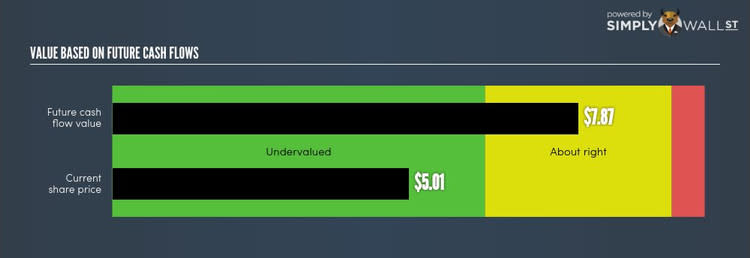An intrinsic value calculation for Pixelworks Inc (PXLW) shows its 36% undervalued

In this article I am going to calculate the intrinsic value of Pixelworks (NASDAQ:PXLW) by taking the expected future cash flows and discounted them to the value today. Discounted Cash Flow or DCF is a direct valuation technique that values a company by projecting its future cash flows and then discounting them to todays money. Don't get put off by the jargon, the math behind it is actually quite straightforward.
If you want to learn more about discounted cash flow, the basis for my calcs can be read in detail in the Simply Wall St analysis model.
If you are reading this and its not September 2017 then I highly recommend you check out the latest calculation for Pixelworks by following the link below. View our latest analysis for Pixelworks

I use what is known as a 2-stage model, which simply means we have two different periods where we need to estimate cash flows. To start off with we need to foresee the next 5 years of cash flows, seeing as no analyst estimates of Free Cash Flow are available I have extrapolated the most recent reported Free Cash Flow (FCF) based on the average annual revenue growth over the past 5 years. I then discount the sum of these cash flows to arrive at a present value estimate.
Detailed calculation
Please note that the numbers here are in millions apart from the per share values.
5-year cash flow forecast
2017 | 2018 | 2019 | 2020 | 2021 | |
Levered FCF (USD, Millions) | $12.63 | $13.72 | $14.91 | $16.20 | $17.60 |
Source | Extrapolated @ (8.64%) | Extrapolated @ (8.64%) | Extrapolated @ (8.64%) | Extrapolated @ (8.64%) | Extrapolated @ (8.64%) |
Present Value Discounted @ 8.47% | $11.65 | $11.67 | $11.68 | $11.70 | $11.72 |
Present value of next 5 years cash flows: $58
After calculating the present value of cash flows in the intial 5-year period we need to calculate the Terminal Value, which accounts for all the future cash flows beyond the 1st stage. The Perpetuity Method (Gordon Formula) is used to calculate Terminal Value at an annual growth rate equal to the 10 year government bond rate of (2.3%).
Terminal Value
Terminal Value = FCF2021 × (1 + g) ÷ (Discount Rate – g)
Terminal Value = $18 × (1 + 2.3%) ÷ (8.5% – 2.3%)
Terminal value based on the Perpetuity Method where growth (g) = 2.3%: $294
Present value of terminal value: $195
The total value or equity value is then the sum of of the present value of the cash flows.
Equity Value
Equity Value (Total value) = Present value of next 5 years cash flows + terminal value = $58 + $195 = $254
The last step is to then divide the equity value by the number of shares outstanding. If the stock is an depositary receipt (represents a specified number of shares in a foreign corporation) then we use the equivalent number.
Value = Total value / Shares Outstanding ($253.92 / 32.25)
Value per share: $7.87
Finally if we compare the intrinsic value of 7.87 to the current share price of $5.01 we see Pixelworks (NasdaqGM:PXLW) is quite good value at a 36% discount to what it is available for right now.
Important assumptions
Now the most important inputs to a discounted cash flow are the discount rate and of course the actual cash flows. If you don't agree with my result, have a go at the calculation yourself and play with the assumptions. Because we are looking at Pixelworks as potential investors the Cost of Equity is used as the discount rate, not the Cost of Capital (or Weighed Average Cost of Capital/ WACC) which accounts for debt.
In this calculation I've used 8.5% and this is based on a Levered Beta of 0.8. I'm not going to go into how I calculate the Levered Beta in detail, I used the 'Bottom up Beta' method based on the comparable businesses, I also impose a limit between 0.8 and 2 which is a reasonable range for a stable business. Google this if you want to learn more.
Final Words
Whilst important, DCF calculation shouldn’t be the only metric you look at when researching a company. Is Pixelworks in a healthy financial condition? What is the reason for the share price to differ from the intrinsic value? See our latest FREE analysis to find out!
PS. The Simply Wall St app conducts a discounted cash flow for every stock on the NASDAQ every 6 hours. If you want to find the calculation for another other stock just search here.
To help readers see pass the short term volatility of the financial market, we aim to bring you a long-term focused research analysis purely driven by fundamental data. Note that our analysis does not factor in the latest price sensitive company announcements.
The author is an independent contributor and at the time of publication had no position in the stocks mentioned.

 Yahoo Finance
Yahoo Finance 
